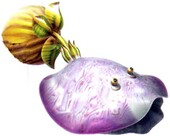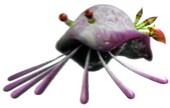Mollusking family: Difference between revisions
mNo edit summary |
(Not so much of a merge, more like a clean (these pages are meant to be simple). I kept the Pikmin 2 TB picture for consistency (looks ugly having the P3 picture here).) |
||
| Line 1: | Line 1: | ||
{{game icons|p2=y|p3=y}} | {{game icons|p2=y|p3=y}} | ||
The '''Mollusking''' family consists of two known species. Attached to the backs of these large, slug-like mollusks is a frilly appendage resembling a berry or a flower bud which functions as the creatures' gills. Such an outlandish means of respiration may seem far-fetched, but a real-world order of [[Wikipedia:Gastropod|snails and slugs]] called [[Wikipedia:nudibranch|nudibranch]]s breathe through colorful frills on their backs. | The '''Mollusking''' family consists of two known species. Attached to the backs of these large, slug-like mollusks is a frilly appendage resembling a berry or a flower bud which functions as the creatures' gills. Such an outlandish means of respiration may seem far-fetched, but a real-world order of [[Wikipedia:Gastropod|snails and slugs]] called [[Wikipedia:nudibranch|nudibranch]]s breathe through colorful frills on their backs. | ||
== Toady Bloyster == | == Toady Bloyster == | ||
[[Image:Toadybloyster.jpg|left|170px]] | |||
{{main|Toady Bloyster}} | {{main|Toady Bloyster}} | ||
Toady Bloysters are slug-like creatures that creep along the ground in search of food, and upon discovering [[Pikmin family|Pikmin]], they lash out their adhesive pseudopodia-like tentacles. Any Pikmin hit by the tentacles stick, and are ingested if the Bloyster is not killed before it can finish "chewing". The gill-like organ on its back is its weak point, being the only damageable spot in ''Pikmin 2'', and a source of extra damage in ''Pikmin 3''. | |||
Toady Bloysters are slug-like creatures | |||
The | |||
When damaged, they attack by shaking their tail in ''Pikmin 2'', and emitting non-fatal ink in ''Pikmin 3''. Entering a [[cave]] makes defeated Toady Bloysters respawn, making the one at the [[Perplexing Pool]] a very low-risk method of spawning large amounts of Pikmin in a short amount of time. | |||
{{clear}} | {{clear}} | ||
== Ranging Bloyster == | == Ranging Bloyster == | ||
[[Image:RangingBloyster.jpg|left|170px]] | |||
{{main|Ranging Bloyster}} | {{main|Ranging Bloyster}} | ||
The Ranging Bloyster is a large form of the Toady Bloyster, named for its longer tentacle mouthparts and bigger size. This creature is difficult to beat because it tracks the player's active [[leader]]. Whatever color the leader's antenna beacon is, the eyes and tail of the Bloyster will change to that color; it also emits a different sound depending on the leader's color. | |||
The Ranging Bloyster is a large form of the Toady Bloyster, named for its longer tentacle mouthparts and bigger size. This creature is difficult to beat because it tracks | |||
The best way to beat it is to lead one of the leaders behind the creature and then have the other leader while the Bloyster faces the diversion pilot, and start [[throw]]ing them on its back or tail while the Bloyster can't face the leader. If it turns around, switching to the other leader to refresh the diversion is a good strategy. | |||
[[Category:Mollusking family| ]] | [[Category:Mollusking family| ]] | ||
[[Category:Families]] | |||
{{Enemies}} | {{Enemies}} | ||
Revision as of 05:01, October 8, 2014
The Mollusking family consists of two known species. Attached to the backs of these large, slug-like mollusks is a frilly appendage resembling a berry or a flower bud which functions as the creatures' gills. Such an outlandish means of respiration may seem far-fetched, but a real-world order of snails and slugs called nudibranchs breathe through colorful frills on their backs.
Toady Bloyster
- Main article: Toady Bloyster.
Toady Bloysters are slug-like creatures that creep along the ground in search of food, and upon discovering Pikmin, they lash out their adhesive pseudopodia-like tentacles. Any Pikmin hit by the tentacles stick, and are ingested if the Bloyster is not killed before it can finish "chewing". The gill-like organ on its back is its weak point, being the only damageable spot in Pikmin 2, and a source of extra damage in Pikmin 3.
When damaged, they attack by shaking their tail in Pikmin 2, and emitting non-fatal ink in Pikmin 3. Entering a cave makes defeated Toady Bloysters respawn, making the one at the Perplexing Pool a very low-risk method of spawning large amounts of Pikmin in a short amount of time.
Ranging Bloyster
- Main article: Ranging Bloyster.
The Ranging Bloyster is a large form of the Toady Bloyster, named for its longer tentacle mouthparts and bigger size. This creature is difficult to beat because it tracks the player's active leader. Whatever color the leader's antenna beacon is, the eyes and tail of the Bloyster will change to that color; it also emits a different sound depending on the leader's color.
The best way to beat it is to lead one of the leaders behind the creature and then have the other leader while the Bloyster faces the diversion pilot, and start throwing them on its back or tail while the Bloyster can't face the leader. If it turns around, switching to the other leader to refresh the diversion is a good strategy.

